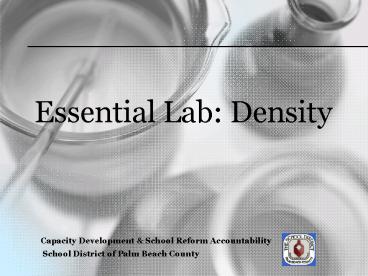Essential Lab: Density PowerPoint PPT Presentation
1 / 26
Title: Essential Lab: Density
1
Essential Lab Density
Capacity Development School Reform
Accountability School District of Palm Beach
County
2
Density Lab
- Read lab
- Discuss and chart the following challenges with
your team - Teachers (content, discipline, motivation)
- Materials
- Students (supporting Levels 1 through 5)
- What can you do to make the lab successful?
3
AGENDA
- Lab Norms
- Benchmark
- Bellringer
- Esstential Lab Using the 5 E Model
- Engage - Activity
- Explore - Lab
- Explain - Post Lab
- Elaborate - Applications
- Evaluate - Assessment
4
LAB NORMS
- 1. Be responsible.
- 2. Follow ALL instructions carefully.
- 3. Please do not touch any equipment, chemicals,
or other materials in the laboratory area until
you are instructed to do so. - Do not eat food, drink beverages, or chew gum in
the laboratory. - Dress properly during a laboratory activity
safety goggles, lab coats, long hair tied back,
no sandals, no dangling jewelry.
5
BENCHMARKS
- SC.A.1.3.1 (AA) Student identifies various ways
in which substances differ (e.g., mass, volume,
shape, density, texture, and reaction to
temperature and light) - I can calculate the density of an irregularly
shaped object using a triple beam balance, water
displacement and the density equation
mass/volume (Dm/v).
6
(No Transcript)
7
(No Transcript)
8
- Cristian is trekking through a desert, he
stumbles across a substance (A) that resembles
gold. Later in the day he stumbles across another
substance that looks similar to the first,
substance (B). Since he wants to cash in on his
discoveries, how can he ensure that what he has
is gold? - Golds density 19.32 g/cm3
- Substance A m120g v 6.21 cm3
- Substance B m120g v 5.1cm3
D 19.32 g/cm3
D 23.5 g/cm3
9
- How can you calculate the density of an
irregularly shaped object?
10
VOCABULARY
- MATTER
- MASS
- VOLUME
- DENSITY
- TRIPLE BEAM BLANCE
- GRADUATED CYLINDER
- WATER DISPLACEMENT
- MENISCUS
11
BACKGROUND INFORMATION
- All matter has mass. Mass is a physical property
that is a measure of the amount of matter in an
object. - Matter also takes up space. The measure of the
amount of space that matter occupies is a
physical property called volume.
12
BACKGROUND INFORMATION
- In science, milliliters (mL) and cubic
centimeters (cm³) are often used to express
volume. A milliliter is equal to a cubic
centimeter (1 mL 1 cm³). - Density is the mass of an object per unit of
volume. Density equals mass divided by volume.
Dm/V
13
BACKGROUND INFORMATION
- You can measure mass using a triple beam balance.
14
Measuring Mass
5th Add the amounts on each beam to find the
total mass to the nearest tenth of a gram.
15
Measuring Mass
Once you have balanced the scale, you add up the
amounts on each beam to find the total mass.
What would be the mass of the object measured in
the picture? _______ ______ _______
________ g
Top Image http//www.southwestscales.com/Ohaus_Tr
iple_Beam_750-SO.jpgBottom Image
http//www.regentsprep.org/Regents/biology/units/l
aboratory/graphics/triplebeambalance.jpg
16
BACKGROUND INFORMATION
- Graduated cylinders are used to measure the
liquid volume when accuracy is important. The
surface of a liquid in a container may be curved.
17
MEASURING VOLUME
18
MEASURING VOLUME
We will be using graduated cylinders to find the
volume of liquids and other objects.
Read the measurement based on the bottom of the
meniscus or curve. When using a real cylinder,
make sure you are eye-level with the level of the
water. What is the volume of water in the
cylinder? _____mL
Top Image http//www.tea.state.tx.us/student.asse
ssment/resources/online/2006/grade8/science/images
/20graphicaa.gifBottom Image http//morrisonlabs
.com/meniscus.htm
19
MEASURING VOLUME
What is the volume of water in each cylinder?
Images created at http//www.standards.dfes.gov.uk
/primaryframework/downloads/SWF/measuring_cylinder
.swf
A
B
C
Pay attention to the scales for each cylinder.
20
BACKGROUND INFORMATION
- The water displacement method is used to measure
the volume of an irregularly shaped object. - For example, to find the volume of a rock, simply
fill a graduated cylinder with water to a
specific level such as 50 mL. - Adding the rock to the graduated cylinder causes
the water level to rise to 65 mL. So, the rock
displaces 15 mL of water. Since 1 mL 1 cm³,
the volume of the rock is 15 cm³.
21
Measuring Volume
We can measure the volume of regular object using
the formula length x width x height.
_____ X _____ X _____ _____
Click here for an online activity about volume.
Choose Lessons ? Volume Displacement
22
- How can you calculate the density of an
irregularly shaped object?
23
Hypothesis
Write a hypothesis using an if then statement
24
Density Lab
- Identify rock sample
- Measure the mass three times
- Measure the volume three times
- Calculate the density
- Average the densities
- Complete data tables
- Graph results
- Answer questions
25
- DENSITY GIZMO
26
Science Capacity Development Team
Cristian Carranza, Science Manager cristian.carran
za_at_palmbeach.k12.fl.us
27
- Cristian is trekking through a desert, he
stumbles across a substance (A) that resembles
gold. Later in the day he stumbles across another
substance that looks similar to the first,
substance (B). Since he wants to cash in on his
discoveries, how can he ensure that what he has
is gold? - Golds density 19.32 g/cm3
- Substance A m120g v 6.21 cm3
- Substance B m120g v 5.1cm3

